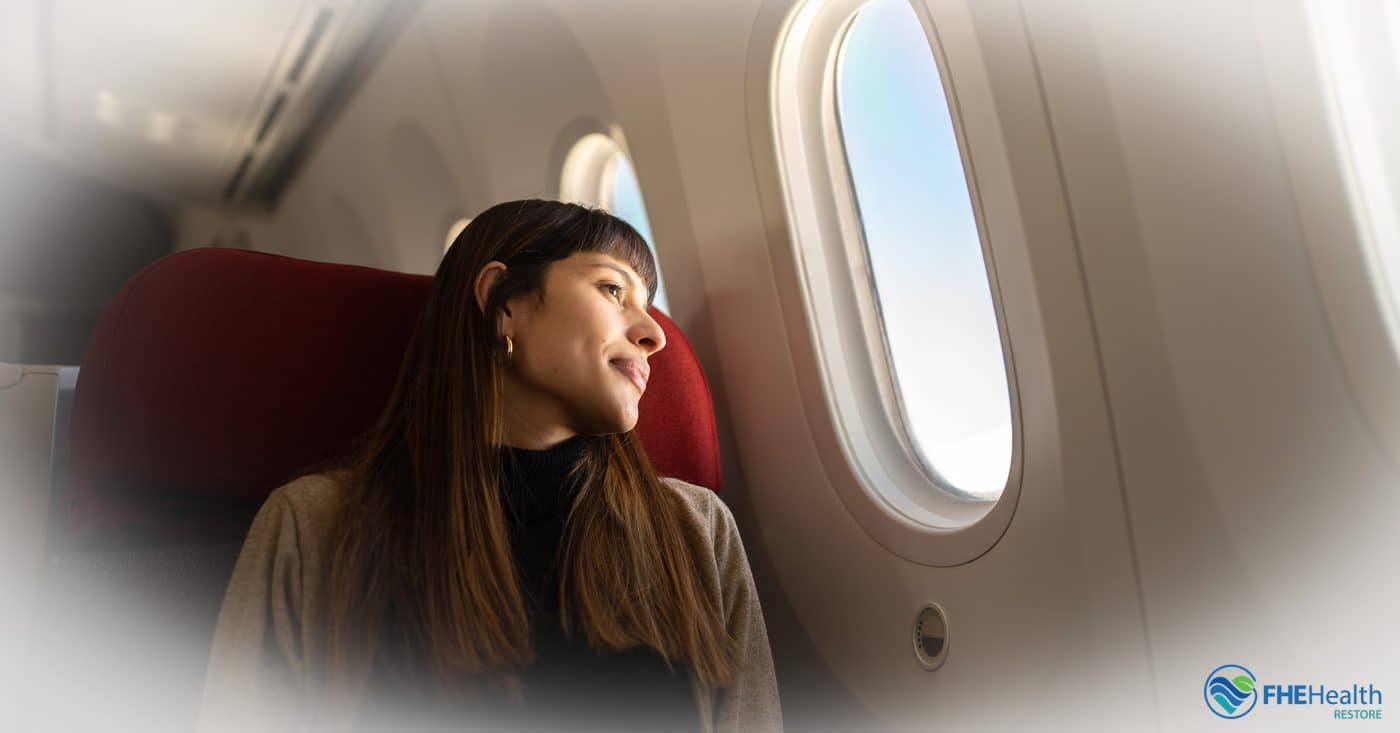Air travel is a modern marvel that puts the entire world within reach. No matter where you are, you’re just hours away from being immersed in another climate and culture. Millions of Americans fly every year, and statistically, flying is significantly safer than driving. Despite the thousands of flights that take off in the United States every day, it’s been over a decade since the nation saw a fatal airplane crash.
Despite all the reassuring statistics, flying isn’t a carefree experience for everyone. The fear of flying, which mental health professionals may refer to as aviophobia or aerophobia, affects about four out of 10 people, and as many as 6.5% of people have a diagnosable phobia of flying.
While this phobia isn’t entirely unreasonable – an airplane failure could have a catastrophic outcome – there may be times when air travel is the fastest and safest option. In some cases, it may be the only option for getting to your destination. For many people, addressing this fear opens them up to new experiences and provides a more peaceful travel experience.
Understanding the Fear of Flying
Aviophobia, or the fear of flying, is a relatively common phobia that’s characterized by feelings of extreme fear or anxiety at the thought of flying or during the experience of air travel. It’s a situational-specific phobia that’s categorized as an anxiety disorder in The Diagnostic and Statistical Manual of Mental Disorders, Fifth Edition.

Aviophobia Definition
Intense irrational fear when traveling by air. Active avoidance of the stimulus negatively affects quality of life and limits functionality.
This phobia can stem from a variety of things, from heavy media coverage of airplane or helicopter accidents to a scary first-hand experience with extreme turbulence. In some cases, extensive airport security measures such as body searches and long lines can create an extra dose of stress on travel days, resulting in travelers already feeling frazzled when they step on the airplane.
In some cases, aviophobia accompanies other phobias related to tight, enclosed spaces, crowds or a fear of heights. These factors, combined with flying itself, can create heightened stress and anxiety.
Regardless of where and when the fear originates, it often brings uncomfortable physical symptoms such as:
- Increased heart rate
- Sweating
- Shaking or trembling
- Nausea
- Dizziness
- Irritability
- Mental fog
For someone who’s had a bad experience with flying or is otherwise apprehensive about air travel, the anticipation of feeling these symptoms can worsen their intensity, creating a cyclical effect. Some people experience feelings of anxiety at even the prospect of planning a future flight. Not only does this significantly limit their recreational options, but it can be a problem for those who are required to travel for their work.
For most people who are afraid of flying, conquering the fear of air travel requires treatment options tailored to their unique needs. Fortunately, there are numerous tips for flying anxiety, including self-help options and professional interventions, that can reduce feelings of anxiety.
Gradual Exposure Techniques for Flight Anxiety
Gradual exposure techniques are among the most common strategies for overcoming the fear of flying, and they can be used independently or under professional guidance from a trained therapist. With this type of therapy, the individual gradually faces situations that are frightening to them. The more positive experiences someone has with something they may be afraid of, such as air travel, the more easily they can learn to manage and minimize that fear.
A person’s starting point with gradual exposure depends on their degree of fear. For some, looking at grounded airplanes is a good place to start, while others may begin their treatment with virtual reality sessions.
Some ways to face your fears through gradual exposure may include:
- Looking at pictures of planes during take-off or landing
- Read about the mechanisms and technologies of some of the most popular planes, as well as their safety features
- Talk to friends and family members about their flight experiences
- Use visualization techniques to imagine being on a smooth flight
- Visit an airport and watch airplanes take off and land, and watch people as they come off the plane
- Talk to a friend about a time they experienced a lot of turbulence on a flight
- Visualize being on a flight with a lot of turbulence
- Watch online videos about flying
- Use virtual reality to safely experience being on an airplane
- Take a short flight
Cognitive Strategies for Conquering Aviophobia
Because fear reaction starts in the brain, retraining the brain is a critical component of flight anxiety management. In addition to gradual exposure, there are cognitive strategies that can help with conquering the fear of air travel.
Identify and Challenge Your Irrational Thoughts
Phobias such as aviophobia generally result from catastrophic thinking, or assuming a catastrophic outcome is inevitable and unavoidable. As you’re thinking about the specifics of your fears, objectively consider outcomes that better reflect reality. Consider the likelihood of an event such as a fatal crash occurring (about 1 in 4 billion) and remind yourself that the vast majority of flights take off and land without incident.
Educate Yourself
Airplanes have more safety features than ever, including hydraulic systems on standby in case of failure, multiple power sources and ground proximity warning systems. On top of that, pilots go through extensive training to safely navigate virtually any circumstance. Educating yourself on these and other safety measures can help you fly confidently.
Set Goals
If your fear of flying has held you back from seeing new places, setting goals can be a good way to pursue progress and conquer your fear of air travel. To make the ultimate goal – flying to a new destination – more attainable, set manageable goals using gradual exposure techniques.
Practice Relaxation Techniques
Relaxation techniques can be effective for managing anxiety as you’re learning flight anxiety management. When you feel stressed related to air travel, use strategies such as progressive muscle relaxation and deep breathing to reduce your anxiety symptoms.
Seeking Professional Help for Fear of Flying
While some people can overcome their fear of flying on their own, professional help may be a better fit for some people, such as those whose fear is genuinely paralyzing or who need to overcome their fear within a certain timeframe.
Mental health care professionals use a variety of therapies to help individuals address their fear, including cognitive behavioral therapy, virtual reality therapy and neuro rehab. They can help you explore and understand the underlying causes of your fear and learn strategies for coping with aviophobia. In more extreme cases, some mental health professionals may prescribe anti-anxiety medications to help someone feel more comfortable when flying.
Aviophobia is among the most common phobias, but the good news is that it’s highly treatable. Understanding the root causes of this fear and incorporating some tips for flying anxiety, along with talking to an experienced mental health care professional, can help you overcome the fear of flying and seek out new destinations.


